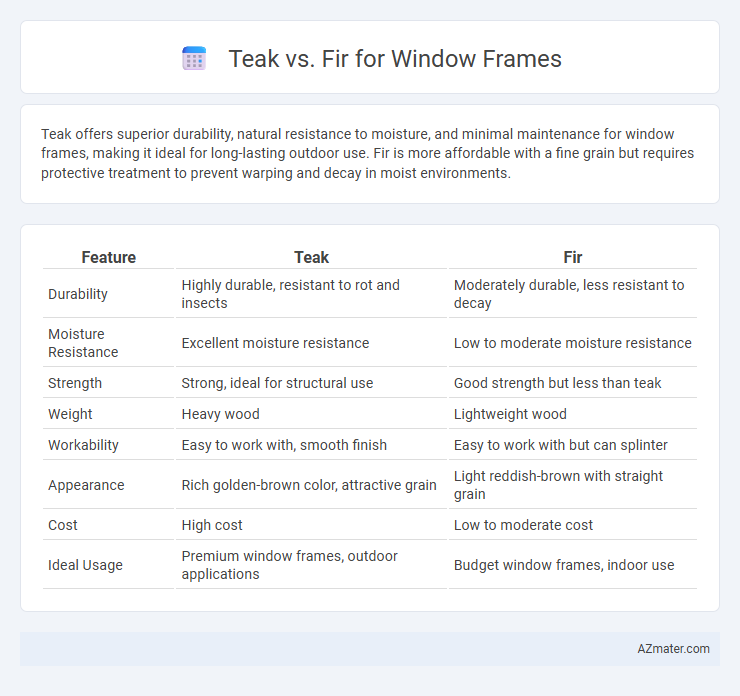Teak offers superior durability, natural resistance to moisture, and minimal maintenance for window frames, making it ideal for long-lasting outdoor use. Fir is more affordable with a fine grain but requires protective treatment to prevent warping and decay in moist environments.
Table of Comparison
| Feature | Teak | Fir |
|---|---|---|
| Durability | Highly durable, resistant to rot and insects | Moderately durable, less resistant to decay |
| Moisture Resistance | Excellent moisture resistance | Low to moderate moisture resistance |
| Strength | Strong, ideal for structural use | Good strength but less than teak |
| Weight | Heavy wood | Lightweight wood |
| Workability | Easy to work with, smooth finish | Easy to work with but can splinter |
| Appearance | Rich golden-brown color, attractive grain | Light reddish-brown with straight grain |
| Cost | High cost | Low to moderate cost |
| Ideal Usage | Premium window frames, outdoor applications | Budget window frames, indoor use |
Introduction to Teak and Fir for Window Frames
Teak wood is renowned for its durability, natural resistance to moisture, and rich golden-brown hue, making it an ideal choice for premium window frames in humid climates. Fir wood offers a lightweight, cost-effective alternative with a straight grain and good stability, suitable for indoor window frames with moderate exposure to weathering. Both species provide distinct benefits in terms of strength, appearance, and maintenance, influencing their selection based on environmental conditions and aesthetic preferences.
Key Physical Properties Comparison
Teak wood features exceptional durability, high natural oil content, and superior resistance to rot and termites, making it ideal for window frames exposed to harsh weather conditions. Fir wood is lighter with moderate strength, offering good dimensional stability but less natural resistance to moisture and pests compared to teak. The dense grain and hardness of teak provide enhanced longevity and low maintenance, while fir's affordability and ease of workability make it a practical choice for indoor or less exposed window applications.
Durability and Lifespan
Teak window frames offer superior durability due to their high natural oil content, which makes them resistant to moisture, insects, and rot, resulting in a lifespan of over 50 years with minimal maintenance. Fir, while less durable and more prone to decay and insect damage, typically lasts around 20 to 30 years when properly treated and maintained. The dense grain and weather-resistant properties of teak make it a preferred choice for longevity in exterior window framing compared to fir's softer and more porous structure.
Resistance to Weather and Moisture
Teak offers superior resistance to weather and moisture due to its natural oils and dense grain, making it highly durable for window frames in humid or rainy climates. Fir, while more affordable, is less resistant to moisture and prone to swelling or warping unless properly treated and maintained. Choosing teak ensures longer-lasting protection against decay and water damage, ideal for exposed window frames.
Aesthetic Differences: Color and Grain
Teak window frames showcase a rich golden-brown color with a tight, straight grain that darkens gracefully over time, adding warmth and elegance to interiors. Fir frames display a lighter, creamy to reddish hue with a pronounced, straight grain pattern that offers a more rustic and natural appeal. Color stability and grain texture distinguish teak as a premium, luxurious choice, while fir provides a bright, organic aesthetic suitable for contemporary and traditional designs.
Maintenance Requirements
Teak window frames require minimal maintenance due to their natural oils that resist moisture, insects, and decay, making them ideal for long-lasting durability. Fir frames, while more affordable, need regular painting or sealing to protect against weather damage and wood rot, increasing upkeep efforts over time. Proper maintenance of fir is essential to prevent deterioration, whereas teak's low-maintenance nature offers cost savings and longevity in window frame applications.
Environmental Impact and Sustainability
Teak is a highly durable hardwood known for its natural oil content, which reduces the need for chemical treatments and decreases environmental impact, making it a sustainable choice when sourced from responsibly managed plantations. Fir, a softwood, grows faster and is more readily renewable, but its susceptibility to rot and insect damage often necessitates chemical preservatives that can harm ecosystems. Choosing FSC-certified teak or fir ensures both materials support sustainable forestry practices, minimizing deforestation and promoting biodiversity.
Cost Analysis: Teak vs Fir
Teak window frames typically cost significantly more than fir due to their natural durability, resistance to rot, and premium aesthetic. Fir is a more budget-friendly option, offering acceptable strength and stability but usually requiring additional treatments to match teak's longevity. When considering long-term value, teak's higher upfront price often offsets maintenance and replacement costs associated with fir.
Installation Considerations
Teak offers superior durability and natural resistance to moisture, making it ideal for window frames in humid or rainy climates, but its dense grain requires specialized tools and skilled labor for precise installation. Fir, being softer and lighter, allows for easier cutting and handling, reducing installation time and labor costs, though it demands thorough sealing to prevent warping and decay. Proper assessment of environmental exposure and installer expertise is critical to ensure longevity and performance of teak or fir window frames.
Best Uses and Recommendations
Teak offers superior durability, water resistance, and natural oils that make it ideal for window frames in humid or coastal environments, ensuring long-lasting performance with minimal maintenance. Fir, a softwood with a fine grain, is better suited for interior window frames and moderate climates where budget-friendly options are desired without compromising structural strength. For optimal results, choose teak for exterior applications requiring weather resistance and fir for indoor settings with controlled moisture levels.

Infographic: Teak vs Fir for Window Frame
 azmater.com
azmater.com